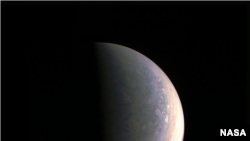New images of Jupiter’s north pole taken by NASA’s Juno space probe show weather and storm activity “unlike anything previously seen on any of our solar system’s gas-giant planets.”
The images were captured during Juno’s first of 36 orbital flybys on Aug. 27 when the probe was a mere 4,200 kilometers above the planet's clouds.
“First glimpse of Jupiter’s north pole, and it looks like nothing we have seen or imagined before,” said Scott Bolton, principal investigator of Juno from the Southwest Research Institute in San Antonio. “It’s bluer in color up there than other parts of the planet, and there are a lot of storms. There is no sign of the latitudinal bands or zone and belts that we are used to -- this image is hardly recognizable as Jupiter. We’re seeing signs that the clouds have shadows, possibly indicating that the clouds are at a higher altitude than other features.”
In addition to images, Juno’s numerous scientific instruments also collected data on Jupiter. For example, the Jovian Infrared Auroral Mapper (JIRAM) allowed researchers to peer beneath Jupiter’s clouds.
“JIRAM is getting under Jupiter’s skin, giving us our first infrared close-ups of the planet,” said Alberto Adriani, JIRAM co-investigator from Istituto di Astrofisica e Planetologia Spaziali, Rome. “These first infrared views of Jupiter’s north and south poles are revealing warm and hot spots that have never been seen before. And while we knew that the first-ever infrared views of Jupiter's south pole could reveal the planet's southern aurora, we were amazed to see it for the first time. No other instruments, both from Earth or space, have been able to see the southern aurora. Now, with JIRAM, we see that it appears to be very bright and well-structured. The high level of detail in the images will tell us more about the aurora’s morphology and dynamics.”
Another instrument recorded “ghostly-sounding transmissions” from the gas giant. They have been known about since the 1950s, but the Juno flybys should allow researchers to investigate them more thoroughly.
“Jupiter is talking to us in a way only gas-giant worlds can,” said Bill Kurth, co-investigator for the Waves instrument from the University of Iowa, Iowa City. “Waves detected the signature emissions of the energetic particles that generate the massive auroras which encircle Jupiter’s north pole. These emissions are the strongest in the solar system. Now we are going to try to figure out where the electrons come from that are generating them.”










